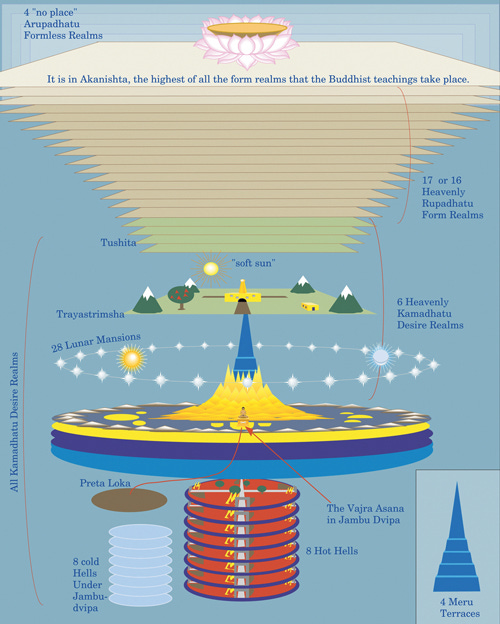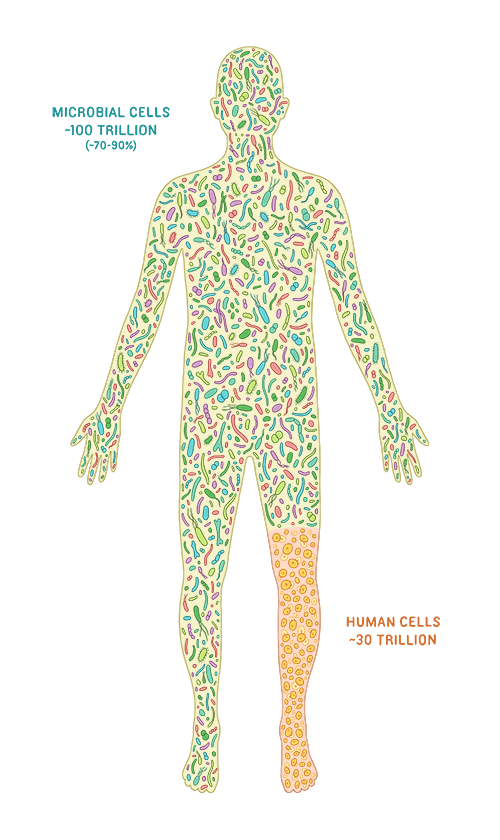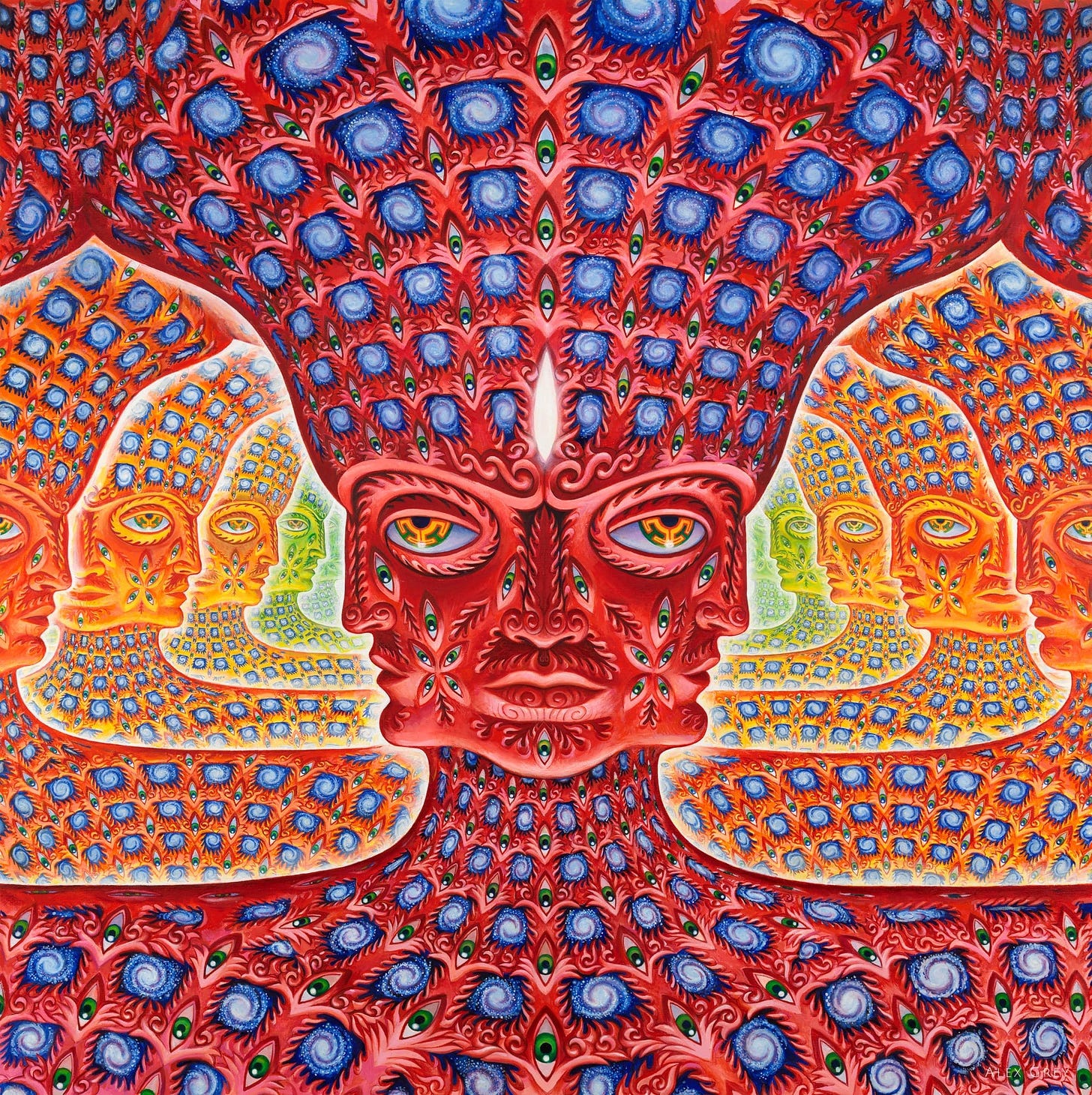Understanding the Buddhist Multiverse.
If a Trichiliocosm is something like the body of a Buddha, then the Second Order Universe would be something like the atoms, and the First order universe something like the subatomic particles.
In Buddhism, a Great Trichiliocosm is a Third Order Universe. It is defined as a system of a billion worlds.
There are potentially infinite Trichiliocosms, as every single Supremely Enlightened Buddha is co-terminus with one, and there are infinite such Buddhas.
For example, according to the Vimalakirti Sutra, our Trichiliocosm is known as the Sahā World, which is the Pureland of Shakyamuni Buddha, yet we cannot perceive it as such, because our minds are impure.
But what does a Third Order Universe mean, precisely?
The First Order Universe
A First Order Universe, or a thousand world system, consists of 1000 small world system. Such an universe is also the experience of the beings which belong to the Desire Realm (Kāmadhātu), which includes human beings.
A small world system is reality as we humans on Earth understand it. This is defined as One World.
A World is classically defined as the axis mundi, Mount Meru, with four great continents (the humans of Earth live on one such continent), two islands around each continent, six heavens above and unspecified number of hells below (there are mythological schemas that group the infinite hells into different types, known as the 8 hot hells and 8 cold hells— but this is a grouping of types, not individual instances of hells, which are innumerable). Every inch of this small universe is inhabited.

How this maps to our understanding of the world is debatable.
Is a Great Continent equivalent to a Planet? Are the islands Moons perhaps?
Or are each Continent different planes or perspective of reality, overlapping each other— since all of them are inhabited by humans, but only our continent has normal humans (the others have distinctly inhuman humans).
Are the six heavens higher planes of existence or yet more planets or realms within our solar system or galaxy?
Or are all of the small world systems more akin to particles, which orbit a greater composition?
Regardless, a thousand such small world systems existing in parallel is within a single Mid-World system, or Second Order Universe.
The Second Order Universe
A Second Order Universe is defined as a system of a million worlds. That is, there are 1000 mid-world systems, with each mid-world system containing 1000 small-world systems.
A Mid-World System contains most of the heavens of the form realms (Rūpadhātu). Again, it’s difficult to say what a Mid-World system corresponds to.
But we know that multiple small world systems “share” a heaven in the Second Order Universe. That is, the worlds of the small world systems are connected in some kind of organism or process, from the perspective of a being from the Second Order Universe.
I have spoken often before of the concept of sentient beings overlapping or interpenetrating each other. How we could be small parts of a deva the size of universes, or perhaps it’s the other way around, the devas (and their worlds) overlap part of our biological and psychological processes. This isn’t a new doctrine per se, as the notion of all worlds existing in each world is a classical Mahayana position.
The 3000 Realms exist in a single moment. The Ten realms interpenetrate each other.

It could be that each Small World System is akin to a particle, and all of those particles form an atom of sorts which the beings of the Mid-World System encompass.
Perhaps we are a particle of a particle. Or a quark of a quark more likely.
In the Flower Garland Sutra, every skin pore of a Buddha contains within it an entire universe, and it is said that there are 84,000 worlds within a drop of water…
The Third Order Universe
A Third Order Universe is simply a thousand Mid-World Systems, or a system of a billion worlds. It denotes the reality as experienced by beings of the formless realms (Ārūpyadhātu). This realm, consisting of merely four heavens, encompass every single world in the Trichiliocosm.
If a Trichiliocosm is something like the body of a Buddha, then the second order Universe would be something like the atoms, and the first order universe something like the subatomic particles.
There are likely infinite Trichiliocosms. The Pureland of Amitabha for example, is said to be located 10,000 Purelands to the “East” of the Human Realm— that is, it is at least 10,000 Third Order Universes away. For this reason, Amitabha is conceived of as an “Alien” Buddha, one that does not originate from Earth, nor from our Trichiliocosm.
This becomes somewhat political later on, when certain Mahayana Theologies emphasize different soteriological objectives. Some argue that Buddhists that originate from Earth should be committed to staying in this Trichiliicosm and saving the people here instead of “escaping” to some foreign, alien Trichiliocosm.
We can roughly categorize these two tendencies as devotees of Amitabha (an ancient alien Buddha that established a Pureland in a distant far-away universe) vs devotees of Maitreya (the future Buddha that will establish a Pureland in the Human World and transform our Trichiliocosm).
Buddhists used to vow to be reborn in Tushita Heaven (the current court of Maitreya), but over time, the majority of Mahayana came to prefer the Pureland of Amitabha; however with the advent of Humanistic Buddhism, notable figures like Taixu expressed a desire to be reborn in Tushita to meet Maitreya and serve his goals.
We only have the human POV
Because this cosmology was taught to us by the Buddha, and all Buddhist Cosmology is implicitly understood as anthropocentric, it is likely that this is not a complete view of the multiverse.
There could be orders of universes smaller than even we are, perhaps our own body contains within it entire universes too, but as this is largely pointless for humans to ponder, it is not necessary for us to be told about it. It makes one think about the human microbiome for sure though.
That’s just my perspective on how to parse the cosmology of course.
Pureland and Trichiliocosms
Furthermore, a Pureland is the same as a Trichiliocosm, only differing on whether you intimately experience it as a Pureland or not. A Pureland is also the same as a Buddha for obvious reasons. All Purelands are manifestations of a Buddha’s Enjoyment Body, and a Pureland’s “limits” is the same as that of the Trichiliocosm. In essence, a given Trichiliocosm is a given Buddha’s Body. Which brings us back to the analogy of subatomic particles being processes within the body of a higher order being, of which the highest order reality is a Buddha (and all Buddhas ultimately have the same Dharmakaya/Dharma-Dhatu). A curious thing in Buddhist discourse is that “Body” (kaya), “Realm” (dhatu) are often conflated or connected when it comes to the theologies of the nature of reality, sentient beings, and Buddhas. We are spheres of experiences and process, not individual beings.
Time
It’s also important to keep in mind that TIME moves, and that everything is a process of change. So these cosmic organism and processes are in a state of change, or interaction, just like any living being or matter. Worlds come into being and dissolves, just like heavier elements arise from nuclear fusion and will one day decay. Space-Time expands and Entropy increases. Mountains eventually ground into dust. Buddhist Cosmology has a rich temporal cosmology as well, describing everything from the beginning of the universe to its cyclical dissolution. Such is the way.


![Syn_[C]pnk's avatar](https://substackcdn.com/image/fetch/$s_!dOdJ!,w_36,h_36,c_fill,f_auto,q_auto:good,fl_progressive:steep/https%3A%2F%2Fsubstack-post-media.s3.amazonaws.com%2Fpublic%2Fimages%2F92148dcd-69c3-44da-adb0-a142bbb787e1_320x320.jpeg)
